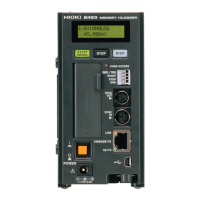5.4 Advanced Settings for Each Channel
99
5
Chapter 5 Setting Measurement Conditions
In the case of the 8996 Digital/Pulse Unit (totalization measurement):
Use of the scaling function enables converting the totalized number of pulses to
the physical quantity (Wh, VA, etc.) of the measurement object in order to per-
form measurement. For pulse output devices, the physical quantity per pulse or
the number of pulses per fundamental unit (e.g., 1 kWh, 1 liter, 1 m
3
) is deter-
mined. You can use either of the settings in the scaling settings. The following
two types of scaling methods are available.
• Setting method 1
Enter the physical quantity per pulse.
• Setting method 2
Enter the number of pulses per fundamental unit.
In the case of the 8996 Digital/Pulse Unit (rotation rate measurement):
Use of the scaling function enables converting the number of pulses per second
to the rotation rate per unit time in order to perform measurement.
• Setting by ratio
Set the unit time and offset value, and convert to the rotation rate per unit
time.
• Setting by 2 points
Set the rotation rate at 2 points of the number of input pulses, the conversion
value of those 2 points, and the unit name for conversion, and convert to the
rotation rate per unit time.
1. Select the channel you want to set on the display settings page of the
channel settings.
2. Set the number of display digits and scaling.
(1) Click
Narrowing down of display
channels (p. 129)
Copy the channel setting information
to another channel (p. 128)
(2) Select
Selectable
Items
Explanations
OFF Scaling will not be converted.
Decimal Scaling will be converted and the value displayed by decimal.
Exponential Scaling will be converted and the value displayed by exponential.

